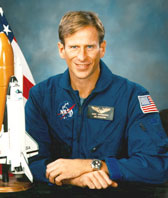 |

|
|
||||
|
Michael L. Gernhardt (Ph.D.) NASA BIOGRAPHY Posted: July 8, 2001 PERSONAL DATA: Born May 4, 1956, in Mansfield, Ohio. Single. He enjoys running, swimming, flying, fishing, and scuba diving. His father, George M. Gernhardt, resides in Marco Island, Florida. His mother, Suzanne C. Winters, resides in Whitestone, Virginia. HONORS: NASA Space Flight Medals (3); Exceptional Service Medals (2); Exceptional Achievement Medal (1). EDUCATION: Graduated from Malabar High School, Mansfield, Ohio, in 1974; received a bachelor of science degree in physics from Vanderbilt University in 1978; master of science degree and a doctorate in bioengineering from University of Pennsylvania, in 1983 and 1991, respectively. ORGANIZATIONS: American Institute of Aeronautics and Astronautics (AIAA); Undersea and Hyperbaric Medical Society; Sea Space Symposium; Aerospace Medical Association. EXPERIENCE: From 1977 to 1984, Gernhardt worked as a professional deep sea diver and project engineer on a variety of subsea oil field construction and repair projects around the world. He has logged over 700 deep sea dives and has experience in air, mixed gas, bounce bell and saturation diving. During his diving career Gernhardt attended graduate school at the University of Pennsylvania and developed a new theoretical decompression model based on tissue gas bubble dynamics. He then participated in the development and field implementation of a variety of new decompression tables. From 1984 to 1988, Gernhardt worked as Manager and then Vice President of Special Projects for Oceaneering International. During this time he led the development of a telerobotic system for subsea platform cleaning and inspection as well as a variety of new diver and robot tools. In 1988 he founded Oceaneering Space Systems, a wholly owned subsidiary of Oceaneering International. From 1988 until his selection by NASA in 1992, he worked on the development of new astronaut and robot-compatible tools for performing maintenance on Space Station Freedom. He also worked on the development of new portable life support systems and decompression procedures for extravehicular activity. NASA EXPERIENCE: Dr. Gernhardt was selected by NASA in March 1992, and reported to the Johnson Space Center in August 1992. Technical assignments to date include: flight software verification in the Shuttle Avionics Integration Laboratory (SAIL); development of nitrox diving to support training for the Hubble Space Telescope repair and on a variety of Space Station EVA developments; member of the astronaut support team at Kennedy Space Center, Florida, responsible for Shuttle prelaunch vehicle checkout, crew ingress/egress; spacecraft communicator (CAPCOM) at Mission Control Center, Houston, during various Shuttle missions; currently leading an international effort to develop new prebreathe procedures for future spacewalks from an International Space Station. A three flight veteran, Dr. Gernhardt has logged over 931 hours in space, including 6 hours and 46 minutes of EVA. He was a mission specialist on STS-69 (September 7-18, 1995), STS-83 (April 4-8, 1997) and STS-94 (July 1-17, 1997). Dr. Gernhardt is assigned to STS-104, where he will perform three spacewalks related to the assembly of the International Space Station (ISS). Launch is targeted for 2001. SPACE FLIGHT EXPERIENCE: STS-69's prime objective was the successful deployment and retrieval of a SPARTAN satellite and the Wake Shield Facility (WSF). The WSF is designed to evaluate the effectiveness of using this free-flying experiment to grow semiconductors, high temperature superconductors and other materials using the ultra-high vacuum created behind the spacecraft near the experiment package. Dr. Gernhardt was one of two astronauts to perform a spacewalk to evaluate future Space Station tools and hardware, logging 6 hours and 46 minutes of EVA. Mission duration was 260 hours, 29 minutes, and 8 seconds, traveling 4.5 million miles in 171 orbits of the Earth. STS-83, the Microgravity Science Laboratory (MSL-1) Spacelab mission, was cut short because of problems with one of the Shuttle's three fuel cell power generation units. Mission duration was 95 hours and 12 minutes, traveling 1.5 million miles in 63 orbits of the Earth. STS-94 was a re-flight of the Microgravity Science Laboratory (MSL-1) Spacelab mission, and focused on materials and combustion science research in microgravity. Mission duration was 376 hours and 45 minutes, traveling 6.3 million miles in 251 orbits of the Earth.
|

Status Summary See the Status Center for full play-by-play coverage. |